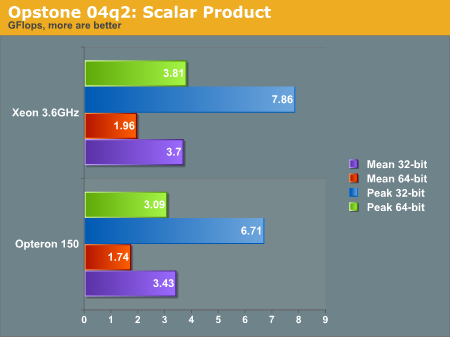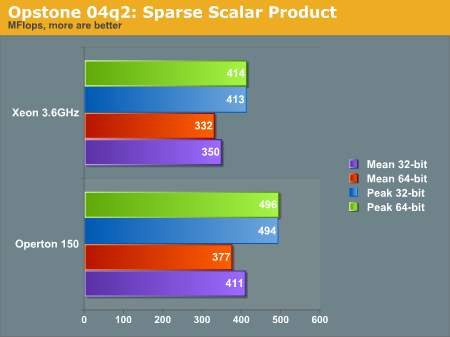Linux Shootout: Opteron 150 vs. Xeon 3.6 Nocona
by Kristopher Kubicki on August 12, 2004 2:35 PM EST- Posted in
- Linux
Opstone
Since our use of Ubench in the previous article clearly infuriated many people, we are going to kick that benchmark to the side for the time being until we can decide a better way to implement it.
In the meantime, a reader suggested we give Blue Sail Software's Opstone benchmarks a try. In this portion of the review, we will use their precompiled optimized binaries of the Scalar Product (SP) and Sparce Scalar Product (SSP) benchmark. The SP benchmark is explained by the author:
"The 'SP' benchmark calculates the scalar product (dot product) of 2 vectors ranging in size from 16 elements to 1048576 elements for both single and double-precision floats. Although the Gflops/sec. for every vector length is recorded (in the resulting output log file), the average of all these values is reported. This benchmark is indicative of the performance of many raw floating-point data processing apps (movie format conversion, MP3 extraction, etc.)"
Note that we ran the P4 optimized binaries on the Nocona, which did not provide x86-64 enhancements. Running the AMD64 binaries on the Xeon yielded poor results. The P4 Opstone binaries are the only 32-bit binaries used in this analysis.

Below is the SSP benchmark, as explained by the author:
"The 'ssp' benchmark also calculates the scalar product of 2 vectors, except that these vectors are sparsely populated (only the non-zero value elements are stored) ranging from a 'loading factor' (non-zero/zero elements) of 0.000001 to 0.01 for both single and double-precision floats. Since the data is not contiguous in memory, the performance is much lower than regular 'sp' and is measured in Mflops/sec. There is not much difference in performance between different loading factors as this benchmark really challenges the ability of the processor to perform short bursts of calculations coupled with lots of conditional testing. It is this reason that the P4 with its longer pipeline does not generally perform as well as the Athlon64. This benchmark is indicative of the performance of many 3D games as the processing is similar (short bursts of calculations with numerous conditional testing)"

There is a general distrust of synthetic benchmarks, so take this portion of the analysis only with a grain of salt. We see a tale of two processors in these graphs; generally the Xeon performs better in the raw operation SP benchmark, while the Opteron performs better in the condition testing SSP benchmark. We would be lead to believe the Intel processor does content integer content creation better than the Opteron, and visa versa with floating point applications. However as we see in the rest of the review, this is not always the case.










92 Comments
View All Comments
epicstruggle - Thursday, August 12, 2004 - link
"The 3.6F will still be marketed against the 3500+/3800+ dual channel AMD CPUs. The benchmarks were messed up in that article, not our processor choice. This was addressed at the beginning of both articles"First great redo. :) I dont care who wins or looses, but at least now the comparision is fair.
About the above quote, who is doing this marketing/comparison. Im assuming Intel? Doesnt it look suspect that they want to compare a 800+ dollar processor with one in the low 300s? Why fall for marketing pr/fud?
again, thanks for the info.
epic
dke - Thursday, August 12, 2004 - link
I enjoyed this article much more than the first one. This one is much more accurate in my opinion.I would like to point out that you can purchase an Opteron 150 (boxed) for $594.49 with free shipping at
http://www.chumbo.com/info.asp?s=030143803701&...
and not $850 like you quoted in your "Final Thoughts" page. Additionally, AMD's pricing page suggests that the Opteron 150 be priced at $637. Any store pricing the Opteron 150 at $800 or $850 will not make any sales, so, I don't think you can justify your statement, "Thus, it is priced around $850 at time of publication." That is the only thing I think you should change with this article. That sentence should be changed to, "Thus, it is priced (by AMD) at around $650 and can be purchased at around $600 at time of publication."
Other than that, I think you've written a wonderful article. I'd also like to thank you for doing this during your "vacation" time. I suppose that wasn't much of a vacation. I think what you did shows quite a bit of dedication to your work, and I (for one) appreciate it.
love4ever - Thursday, August 12, 2004 - link
thanks Kristopher.very nice review.
Carfax - Thursday, August 12, 2004 - link
Kris, that's fine man.. Good work on this review, and I look forward to seeing the 32 and 64 bit Nocona benches in a future review!KristopherKubicki - Thursday, August 12, 2004 - link
datacipher: The 3.6F will still be marketed against the 3500+/3800+ dual channel AMD CPUs. The benchmarks were messed up in that article, not our processor choice. This was addressed at the beginning of both articles/Kristopher
datacipher - Thursday, August 12, 2004 - link
Sorry for the empty posts, I just signed up to say this....I think I can speak from a different perspective as I am not a techhead. I do keep a casual eye on hardware and have done extensive programming so I would not classify myself as computer illiterate.
Still I WOULD not have noticeed the rediculous choice of cpu's used in the 1st article. I would have just skimmed the article and assumed that a reasonable choice of benchmark material was used. I would not have known about any of the flaws in the benchmarks. I WOULD have accepted and given weight to the conclusion...which was clearly unwarranted given this second review.
I would like to thank all the posters who criticized that review because without you watchdogs, I would have blindly accepted the article as I used to do with Anandtech which I always though was a reliable source.
Kristopher, it's good you posted a new article, but honestly, your first article was extremely misleading...almost fraudulent...it really changes the nature of Anandtech in my mind...I thought I could rely on you fellows...
If you had initially even written of your reasoning as to why you were using such an uncomparable processor and then properly framed your conclusions it would have been fine....but in the article itself you seemed to be saying that it was a reasonable comparision and the conclusions were not given proper reference.
I'm really disappointed.
KristopherKubicki - Thursday, August 12, 2004 - link
Carfax:I will address that in a future review. I just didnt have the time to do it all over again :'(
Kristopher
Carfax - Thursday, August 12, 2004 - link
This review is MUCH better.. But still, WHY aren't there reference 32 bit scores for the Noconca, so we can see how much of a difference between 32 and 64 bit performance there is?TotalImmortal - Thursday, August 12, 2004 - link
thanks to all you guys at anandtech, never let it be said that you don't listen to your readership!sprockkets - Thursday, August 12, 2004 - link
At the end of page 5, the last paragraph is worded weird. Page 6 graph at the top, "Opteron 250"?I realize that you probably were sleeping when you did this :).
The only thing else I don't like and I know it's out of your control is those stupid "get the facts" propaganda from Micro losers.